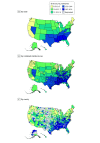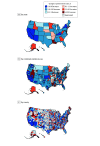US County-Level Variation in Preterm Birth Rates, 2007-2019
- PMID: 38064212
- PMCID: PMC10709777
- DOI: 10.1001/jamanetworkopen.2023.46864
US County-Level Variation in Preterm Birth Rates, 2007-2019
Abstract
Importance: Preterm birth is a leading cause of preventable neonatal morbidity and mortality. Preterm birth rates at the national level may mask important geographic variation in rates and trends at the county level.
Objective: To estimate age-standardized preterm birth rates by US county from 2007 to 2019.
Design, setting, and participants: This serial cross-sectional study used data from the National Center for Health Statistics composed of all live births in the US between 2007 and 2019. Data analyses were performed between March 22, 2022, and September 29, 2022.
Main outcomes and measures: Age-standardized preterm birth (<37 weeks' gestation) and secondarily early preterm birth (<34 weeks' gestation) rates by county and year calculated with a validated small area estimation model (hierarchical bayesian spatiotemporal model) and percent change in preterm birth rates using log-linear regression models.
Results: Between 2007 and 2019, there were 51 044 482 live births in 2383 counties. In 2007, the national age-standardized preterm birth rate was 12.6 (95% CI, 12.6-12.7) per 100 live births. Preterm birth rates varied significantly among counties, with an absolute difference between the 90th and 10th percentile counties of 6.4 (95% CI, 6.2-6.7). The gap between the highest and lowest counties for preterm births was 20.7 per 100 live births in 2007. Several counties in the Southeast consistently had the highest preterm birth rates compared with counties in California and New England, which had the lowest preterm birth rates. Although there was no statistically significant change in preterm birth rates between 2007 and 2019 at the national level (percent change, -5.0%; 95% CI, -10.7% to 0.9%), increases occurred in 15.4% (95% CI, 14.1%-16.9%) of counties. The absolute and relative geographic inequalities were similar across all maternal age groups. Higher quartile of the Social Vulnerability Index was associated with higher preterm birth rates (quartile 4 vs quartile 1 risk ratio, 1.34; 95% CI, 1.31-1.36), which persisted across the study period. Similar patterns were observed for early preterm birth rates.
Conclusions and relevance: In this serial cross-sectional study of county-level preterm and early preterm birth rates, substantial geographic disparities were observed, which were associated with place-based social disadvantage. Stability in aggregated rates of preterm birth at the national level masked increases in nearly 1 in 6 counties between 2007 and 2019.
Conflict of interest statement
Figures



References
-
- Martin JA, Hamilton BE, Osterman M. Births in the United States, 2020. NCHS Data Brief. 2021;(418):1-8. - PubMed
-
- Blencowe H, Cousens S, Oestergaard MZ, et al. . National, regional, and worldwide estimates of preterm birth rates in the year 2010 with time trends since 1990 for selected countries: a systematic analysis and implications. Lancet. 2012;379(9832):2162-2172. doi:10.1016/S0140-6736(12)60820-4 - DOI - PubMed
Publication types
MeSH terms
Grants and funding
LinkOut - more resources
Full Text Sources
Miscellaneous

